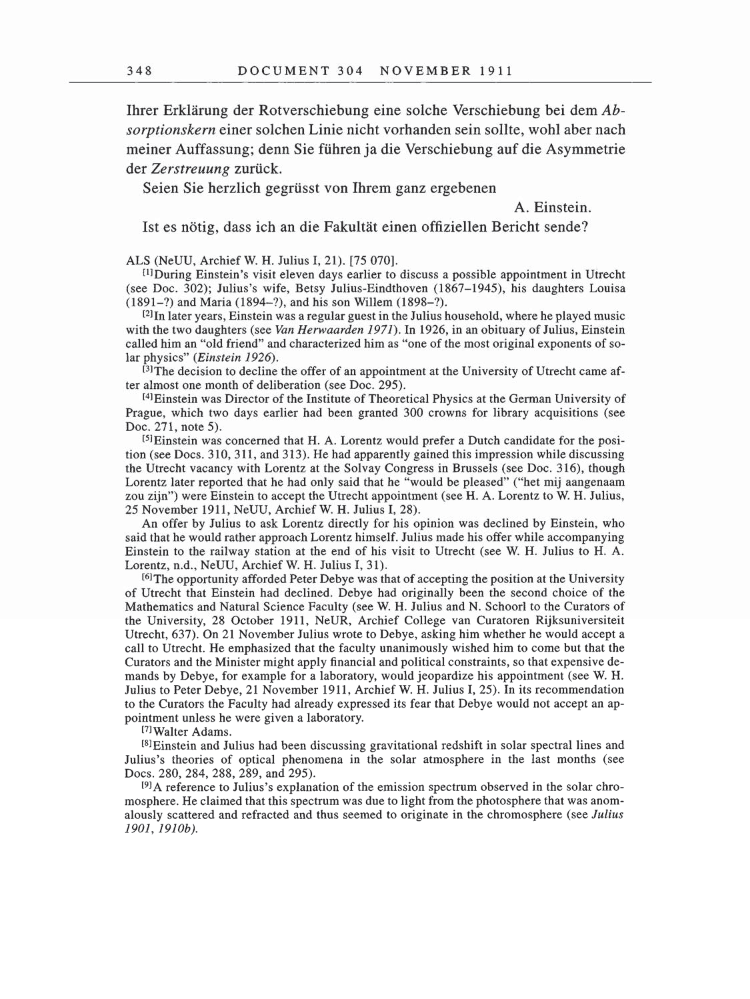348 DOCUMENT 304 NOVEMBER 1911 Ihrer Erklärung der Rotverschiebung eine solche Verschiebung bei dem Ab- sorptionskern einer solchen Linie nicht vorhanden sein sollte, wohl aber nach meiner Auffassung denn Sie führen ja die Verschiebung auf die Asymmetrie der Zerstreuung zurück. Seien Sie herzlich gegrüsst von Ihrem ganz ergebenen A. Einstein. Ist es nötig, dass ich an die Fakultät einen offiziellen Bericht sende? ALS (NeUU, Archief W. H. Julius I, 21). [75 070]. [1]During Einstein's visit eleven days earlier to discuss a possible appointment in Utrecht (see Doc. 302) Julius's wife, Betsy Julius-Eindthoven (1867-1945), his daughters Louisa (1891-?) and Maria (1894-?), and his son Willem (1898-?). [2]In later years, Einstein was a regular guest in the Julius household, where he played music with the two daughters (see Van Herwaarden 1971). In 1926, in an obituary of Julius, Einstein called him an "old friend" and characterized him as "one of the most original exponents of so- lar physics" (Einstein 1926). [3]The decision to decline the offer of an appointment at the University of Utrecht came af- ter almost one month of deliberation (see Doc. 295). [4]Einstein was Director of the Institute of Theoretical Physics at the German University of Prague, which two days earlier had been granted 300 crowns for library acquisitions (see Doc. 271, note 5). [5]Einstein was concerned that H. A. Lorentz would prefer a Dutch candidate for the posi- tion (see Docs. 310, 311, and 313). He had apparently gained this impression while discussing the Utrecht vacancy with Lorentz at the Solvay Congress in Brussels (see Doc. 316), though Lorentz later reported that he had only said that he "would be pleased" ("het mij aangenaam zou zijn") were Einstein to accept the Utrecht appointment (see H. A. Lorentz to W. H. Julius, 25 November 1911, NeUU, Archief W. H. Julius I, 28). An offer by Julius to ask Lorentz directly for his opinion was declined by Einstein, who said that he would rather approach Lorentz himself. Julius made his offer while accompanying Einstein to the railway station at the end of his visit to Utrecht (see W. H. Julius to H. A. Lorentz, n.d., NeUU, Archief W. H. Julius I, 31). [6]The opportunity afforded Peter Debye was that of accepting the position at the University of Utrecht that Einstein had declined. Debye had originally been the second choice of the Mathematics and Natural Science Faculty (see W. H. Julius and N. Schoorl to the Curators of the University, 28 October 1911, NeUR, Archief College van Curatoren Rijksuniversiteit Utrecht, 637). On 21 November Julius wrote to Debye, asking him whether he would accept a call to Utrecht. He emphasized that the faculty unanimously wished him to come but that the Curators and the Minister might apply financial and political constraints, so that expensive de- mands by Debye, for example for a laboratory, would jeopardize his appointment (see W. H. Julius to Peter Debye, 21 November 1911, Archief W. H. Julius I, 25). In its recommendation to the Curators the Faculty had already expressed its fear that Debye would not accept an ap- pointment unless he were given a laboratory. [7]Walter Adams. [8]Einstein and Julius had been discussing gravitational redshift in solar spectral lines and Julius's theories of optical phenomena in the solar atmosphere in the last months (see Docs. 280, 284, 288, 289, and 295). [9]A reference to Julius's explanation of the emission spectrum observed in the solar chro- mosphere. He claimed that this spectrum was due to light from the photosphere that was anom- alously scattered and refracted and thus seemed to originate in the chromosphere (see Julius 1901, 1910b).
